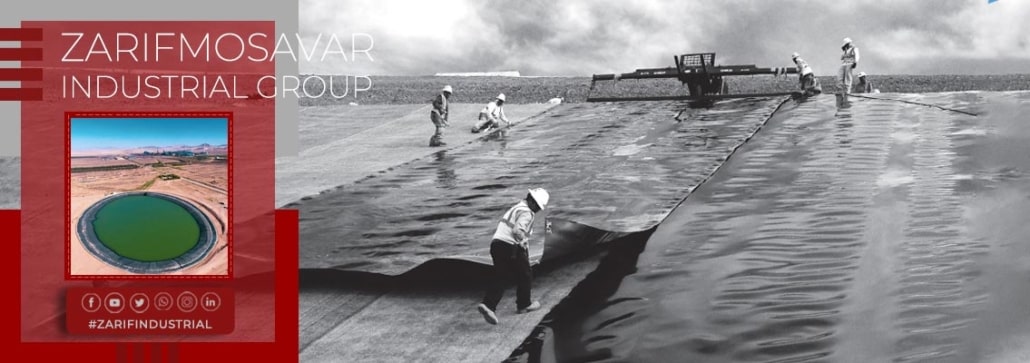Agricultural Water Storage Pool-Geomembrane Pool-Agricultural Pool
Agricultural Water Storage Pool-Geomembrane Pool, Depends on the rate of farming in summer season , and the rate of received rain in other seasons , the water resources shortage would be a serious crisis for farmers , Due to increasing rate of demands for water resources and the existence of some shortages in this process ,the importance of protecting and managing of these resources is being augmented day by day.
Nowadays Agricultural water storage or geomembrane pools are being used more than the concrete, asphalt or bitumen, materials. because they have less economic costs and more life-time and the geomembrane performance costs are lower.
Geomembranes are resistant to sunlight and are much more resistant against cold and warm climate rather than concrete, so that geomembranes would withstand against the temperatures up to + 80 ° C and down to -70 ° C.
Why Geomembrane Pools ?
Geomembrane sheets are nearly 100% impermeable, while concrete, stone, and cement are slightly impermeable. Changing water transfer methods from traditional to modern would be so effective in the field of preventing water loss for distribution networks, and storing water in the rainy or snowy seasons and using this resource for the hot seasons and ease of dewatering at any time of the day or night are some benefits of water storage pools which are implemented by
more : Zarif Mosavar geomembrane products.
High Density Polyethylene Geomembranes (Manufactured Hdpe Geomembrane By Yalda- Zarif Mosavar Co)
High Density Polyethylene Geomembranes ,(HDPE Geomembranes) which are being produced in Yalda Group (one of Zarif-Mosavar Holding Subsidiaries),are polyethylene narrow sheets included of 2% black carbon or colorful Masterbatches, the thickness of these sheets are varied from 0.2 mm to 5 mm, and the width is between 2 to 8 meters and finally the length would be varied from 50 m to 200m. The Geomembrane sheets would be used as protecting insulating covers for different sorts of tanks and storages.
These products have high physical, mechanical and chemical properties and are so resistive against ultraviolet radiation, frost and chemicals, and its flexibility and long life, are caused to lead to widespread usage in various industries such as water and wastewater, agriculture, dam construction, fisheries, landfills, oil and gas, chemical industries, mining and so on. Read our articles about other used raw materials in geomembranes such as polypropylene and polyvinyl chloride and some additives such as antioxidants, plastics, carbon black and lubricants, etc., along with their application.
More : LLDPE Geomembranes About
9 Step for Agricultural Storage or Geomembrane Pools Construction:
- Determining the location of agricultural water storage pools.
- Calculating the water volume and the geometric shape of the agricultural water storage pools.
- Excavation / embankment and standard flooring of agricultural water storage pool
- Selecting the convenient geomembrane and geotextile sorts for agricultural water storage pools.
- Determining the water input/output points for agricultural water storage pools.
- Performing the geomembrane and geotextile coving along with their welding.
- Creating a protective fence for the agricultural water storage pool.
- Water intake of agricultural water storage pool.
- Final control and filling of agricultural water storage pool’s trench.
1. Locating the agricultural water storage pool (geomembrane pool)
In general , The location of the pool can be selected according to water supply sources such as: water pit, river, aqueduct, spring, flood, etc. and some factors such as the distance to the pool, the slope of the land and the method of transferring water to the pool (pumping, irrigation canal, etc.) and the method of water output to the farm (Gravity, pumping, etc.) would be so effective for this selection, the location should be selected in a method which has the lowest cost and time consuming for pool constructing and leading water to its quitting points. The type of soil structure should also be checked too.
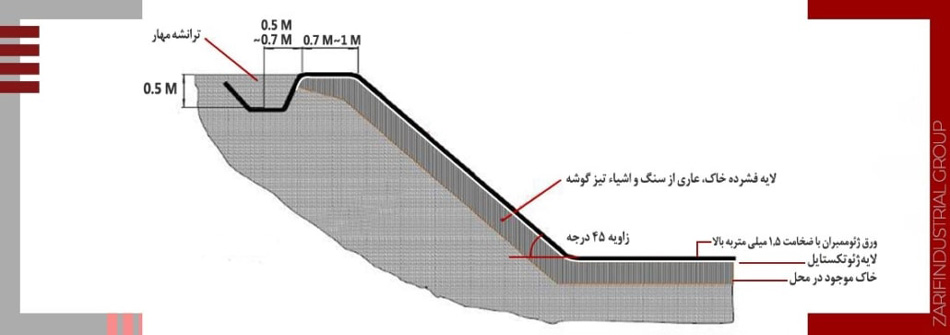
More : Why the Agricultural pool made with geomembrane sheet?
2. The Water Volume and Geometric Shape Calculation for Agricultural water Storage Pools (geomembrane pool)
After mapping, according to the volume of available water resources such as water rights , flow rate , time of water entering to the pool and the volume of water required by the farmer, we calculate the total volume of storable water volume, by considering reliability coefficient.
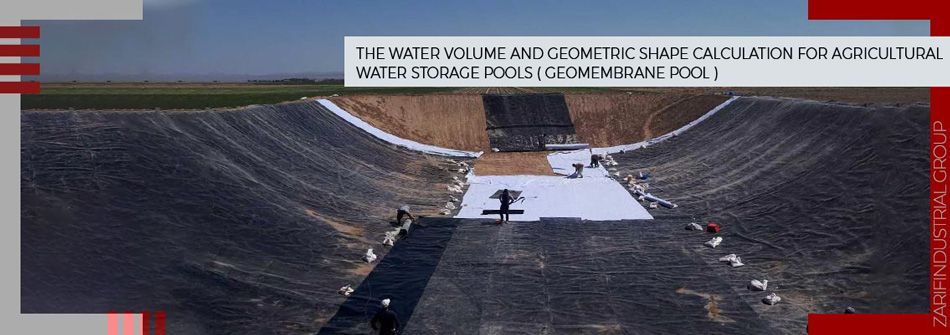
And due to lack of limitation for insulation of geomembranes in the shape and size of the pool, then the calculation of the geometric shape would be done according to the lowest cost of excavation or embankment.
3. Excavation / Embankment And Standard Floor Construction Of Agricultural Water Storage Pool (geomembrane pool)
Proper floor constructing has an important effect on the health and longevity of the geomembrane sheet in the pool and the pool floor would be built either by digging and pit or by embankment performing, but in both cases, the points that must be observed are:
- To prevent the walls from falling, observe the standard slope (1/1) or 45 to 60 degrees of the pool walls.
- Smoothing and compacting surfaces with at least 70% density by pounding rollers and collecting gravel and spraying soft materials such as sand.
- For the beauty of the geometric shape of the pool and the fact that the walls do not collapse, it is plastered with brick and concreted, but it is not necessary.
- Creation of trenches or ponds around the pool in proportion to the depth of the pool with a distance of about 70 to 100 cm with a width of 50 to 70 cm and a depth of 50 cm A pit is dug in which the edges of geomembrane sheets are placed and a number of soil bags are poured. With the addition of water, the sheet can move and be completely fixed in the floor of the bed, and with the full filling of the pool after the leak test, the trench filled with soil or concrete becomes soft.
More : Geotextile Installation Guide in Road Stabilization
4. The Geomembrane and Geotextile Selection for Agricultural Water Storage Pools (geomembrane pool)
Due to the great diversity of geomembranes and their manufacturers, choosing the most appropriate geomembranes would be so important, by proceeding more researches the best product with high quality and standard along with its reputable manufacturer would be identified.
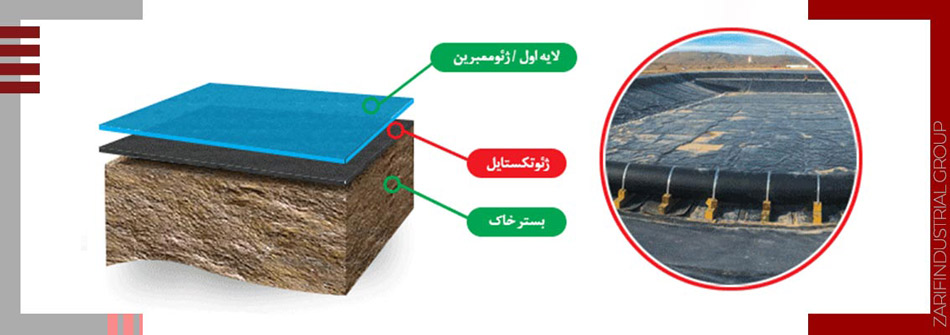
In general, any type of geomembrane sheet with any brand must have the specification sheet along with international standard GM13 , an exploitation sheet from the Ministry of Industry, Mines and Trade and a 10-year warranty sheet , for the depths less than 10 meters and the slope of 45 of 1.5 mm thickness of geomembrane would be recommended and for the Depth greater than 10 meter ,2 mm thickness or more would be suggested.
More : Why Zarif-Mosavar Geomembrane Sheets ?
To prevent any soil erosion , protect geomembranes and prolong its life and avoid geomembranes shrinking, a geotextile protective felt cover which is made of polypropylene PP or PET polyester should be used, which should also have the international standard GT12 and related warranties too, For selecting the type of geotextile depending on the softness of the pool bed, a minimum unit-weight of 300 g and preferably white should be used, and if the amount of pebbles is higher, a higher unit-weight should be used after the announcement of the technical expert.
5. Determination of water input/output for agricultural water storage pools:
Different types of piping:
- Input pipe
- Output pipe
- Water Overflow pipe
The material of all this must be polyethylene and as much as is possible we should not work in the pipes inside the pool and the inlet/input pipe should be worked from the above and if there is any clay in the water we should use the rest pond or multi-layer filter and its outlet should accompanied with pump on the float (preferably by a mesh room made with Plastic and aluminum) or shoe pump.
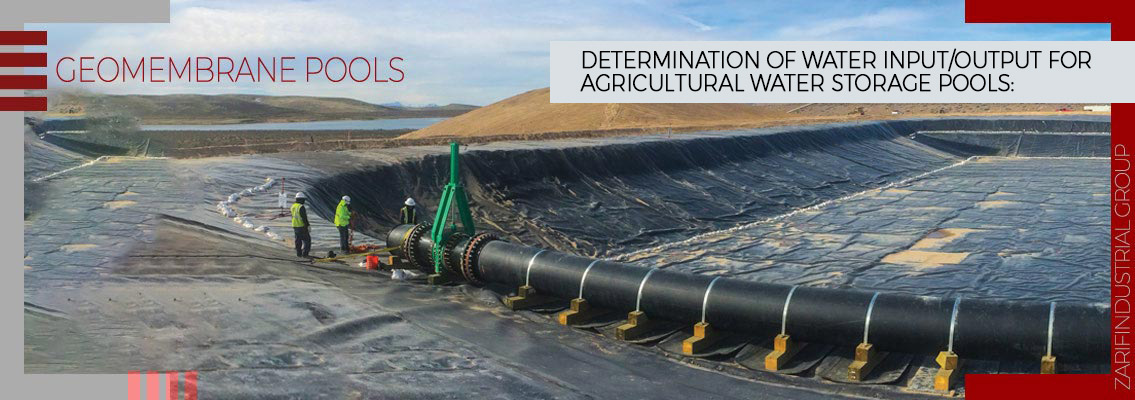
The output pipe must be at a distance of 1 meter from the edges and corners of the floor and it should be place similar as a siphon inside the hole and it should be fixed by concreting 50 cm around it, this action would prevent welding separation from the pipe on the time which water weight caused the pipe over surface falling and it would prevent any water leakage.
If there is necessity for overflow pipe , it should be installed 10 to 50 cm lower than the pool edge and the pipe diameter would be around 25 cm.
6. Execution Of Geotextile And Geomembrane Layers And Their Welding
Please note that in order to install the insulation, the weather conditions must be convenient for welding, For example there should be no rain and the temperature should be between 0 and 70 Celsius degrees.
First, we connect the wide geotextile protective felt cover with a thermal dryer, and then it is time to use the geomembrane layer.
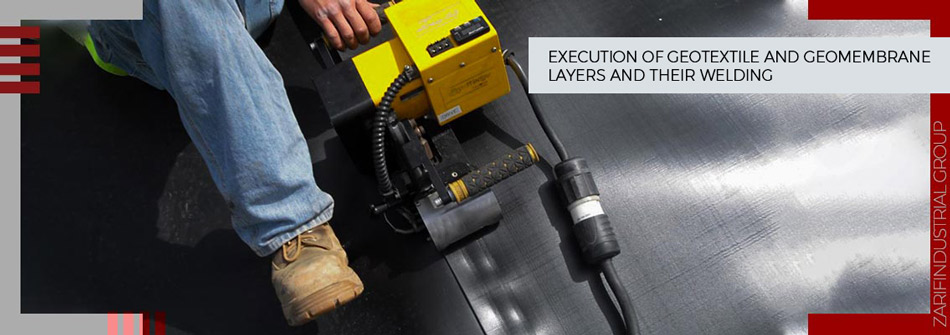
The edges are placed on top of each other and flattened on the floor and walls of the pool. If the edges are clean and dry, the sheets are welded to each other with two welding lines at a distance of 1.5 cm using an automatic thermal welding machine.
and from that empty space we can use to perform discharge test, air pressure test, spark test specially for the large pools.
More : Four Important Points About Geomembrane Sheets Welding
7. Establishing Protective Fence For Agricultural Water Storage Pool (geomembrane pool)
Due to the importance of preventing human or other animal drowning , specially before any water intake, the installation of fences and warning signs is mandatory and in case of any negligence and occurrence of any accidents and financial or human losses, the owner or operator will be found guilty.
The best materials for the fence are galvanized nets by the mesh of 6 * 6 which is produce by wire of 2.5 along with the width of 2m or an iron pipe with a diameter of 5 cm (scaffolding pipe) with a corner beam of 6 and the length of 300 cm which has the bending angle ,50 cm above it.
50 cm lower of that space, it would be placed in concrete by connecting at least three branches, and the connection points of the fence are made of rings with the wire scale of 3 or 4 (welding wire)and holding pipes, and if necessary, barbed wire is installed.
8. The Water Intake for Agricultural Water Storage Pools (geomembrane pool)
After performing different sorts of testing by related technician , checking welding points (if related pipe got applied ), and controlling the connection joints , we would be able to start water intake for the pool.
as the first level of water intake , we should fill up the pool by the height of 50cm to 70cm from its floor surface, and after passing two days (in which the geomembrane sheet could sit well on the pool floor), we would sign the water line then for third and the fourth days, we should recheck the water lines again , by considering of water evaporation rate for each region.
if the water volume is not reduced , we would proceed to perform next testing levels , for these levels , the pool intake would be done for three levels of 30%,60% and 90% of pool volume then after sheet sitting on pool floor , the water lines would be signed , the reason for pool intake on different levels is to prevent to discharge whole pool water if any holes got occurred , and if there is any water leakage , the holes should be recognized and they should be welded again.
9. Final Controlling and Filling the Agricultural Water Storage Pool’s (geomembrane pool) Trench:
During water intake, a number of soil bags are placed in the trench on the edge of the sheets so that with the addition of water, the sheet can move and be completely fixed in the bottom of the pool bed.
hen after pool intake , the trench hole would be filled by soil or light concrete , please consider this point that if this trench got filled sooner , it would cause more strength or sheet tearing which lead to place the air flow between soil and geomembrane , this air-flow would cause the pool insulation life-time reduction and water leakage.

